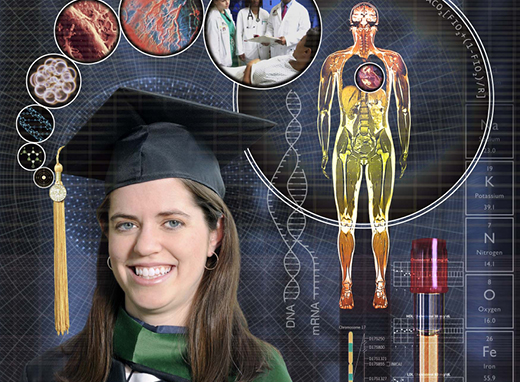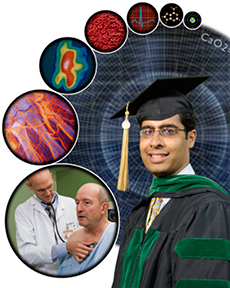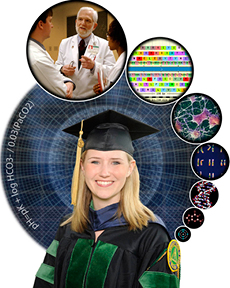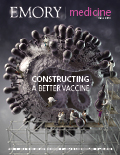A new prescription for medical education

Marybeth Sexton
New alumni are joining the ranks, and their education was nothing like yours.
By Kay Torrance | Illustrations by Ralph Kelliher
Marybeth Sexton adjusted her black cap as she stood in line with her fellow medical school graduates this past May. She and others chatted about their upcoming residencies and summer vacation plans as they waited outside Emory’s Glenn Memorial Church for commencement to begin. They seemed to pay little attention to the historic nature of the day.
Though the medical school dean likes to say that every graduating class is special, this particular one will go into the history books. The class of 2011 is the first class to graduate under the school’s new curriculum—one that was envisioned eight years ago as a new way to educate future doctors.
Across the country, a number of top-tier medical schools have overhauled their curricula to meet a medical landscape that has changed drastically in the past decade. Students today need to be prepared for continually evolving technology, care that is more “patient-centered” in the context of clinician shortages, an aging population, increased attention to health policy, diminishing reimbursements—the list goes on and on.
Before this year’s class joined the ranks, Emory’s medical alumni predominantly sat through traditional lecture-based courses their first two years, with patient contact largely confined to the second half of the medical curriculum. Emory’s new curriculum throws tradition to the wind, with less focus on disease and more emphasis on patients. Old-school courses have given way to more engaging modules that go from person to cell on topics such as aging and cardiology, where students not only learn the science of disease but also work with patients to understand first-hand experiences. Students also had more outpatient experience than previous classes to mimic how most doctors see patients.
“I liked that the curriculum was designed to be ‘systems-based,’” says Sexton, now an internal medicine resident at New York-Presbyterian Hospital-Columbia University Medical Center. “Instead of studying microbiology, pathophysiology, and pharmacology separately, we would focus on cardiology, for example, and examine how each of those topics related to the heart. We would have lectures on bacterial infections of heart valves, the causes of coronary artery disease, and drug treatments for high blood pressure. Studying the material in that way gave me a great framework for evaluating patients in the hospital later on.”
Providing good models
Ryan Summers 11M sat in a small classroom recently with seven other students as they waited for their faculty adviser to arrive. They talked with the ease of lifelong friends even though they had known each other only four years, since the first month of medical school, which now seemed like a lifetime ago.
Summers’ society group is one of 16 in the Class of 2011. The societies often function as a mini-class, covering a number of non-traditional subjects, such as doctor-patient communication, including using open body language, how to break bad news to a patient or discuss the results of genetic tests, or talking about adherence to a medication regimen. The small groups allow more participation from each student, but perhaps more important, the groups provide emotional support.
“The society group experience has been one of the most meaningful experiences in medical school,” says Summers, who is now an Emory pediatrics resident. “Your society adviser becomes your closest friend on the faculty, and the society group is a safe place to share your thoughts and experiences. Your mentor also has the advantage of having been through it all before and can offer insights gained from experience.”
That’s exactly how Monica Farley and Jerry Boss envisioned the society system. Six years ago, Farley, an Emory infectious disease specialist, and Boss, an immunologist, co-chaired a committee of faculty that looked at how to integrate mentoring into the curriculum. “In our minds, the most important thing was to incorporate mentoring into the curriculum—not just a hit or miss thing where students would have to schedule an appointment with an adviser,” Farley says. “We wanted students to have much longer and more quality exposures to faculty and physicians so they can really model themselves after someone whom they have worked with for a long time. I think it’s one of the biggest achievements of this curriculum.”
While other medical schools have societies, “no one does this as robustly as we have,” says Bill Eley, executive associate dean for medical education and student affairs. Emory’s society groups of approximately eight students each spend all four years with the same faculty adviser, mirroring the ideal longtime relationship between patient and doctor. At this year’s commencement, faculty advisers hooded their graduates, assuming a role traditionally held by Eley and Ira Schwartz, associate dean for student affairs.
Farley’s committee strongly recommended salary support for the 64 society group leaders that the school would need. Advisers would be devoting at least three half-days a week for the first two years. “I know that it was one of the first times that the medical school said that we are going to free up clinical time and provide salary support for physicians to mentor and teach medical students,” Farley says.
Since the new curriculum started, the school has spent an additional $4 million annually to help departments pay about a third of each small group leader’s salary.
Discovering research
|
Sameer Nagpal 11M |
Sameer Nagpal 11M was ecstatic to find out that he matched with Yale-New Haven Hospital for a residency in internal medicine. He thinks the medical curriculum’s Discovery Phase, in which students work for five months on a research or creative writing project, helped tip the scales in his favor to secure a top-notch residency.
“The Discovery Phase gave me a mentor who worked with me one-on-one every day for five months, and because of that, allowed me to get a strong letter of recommendation that had substantial weight and meaning behind it,” Nagpal says. “I was asked about my research project at nearly every interview I attended, and everyone, including several cardiologists I interviewed with, was very impressed with the in-depth experience that the Discovery Phase afforded me.
“During medical school, you are forced to learn a little bit about everything in medicine, and the Discovery Phase gives you the chance to go into great detail about a part of medicine that you are really enthusiastic about,” Nagpal says. “I felt very much in charge of my project, from submitting an IRB proposal, to presenting at a national meeting, and writing the manuscript for publication. Because my project was clinically based, I spent lots of time with my attending faculty mentor in the cardiac cath lab, the operating room, the echo lab, and also in the clinic, seeing patients involved in our research project.”
Medical schools typically offer opportunities in research, but few make research or a creative writing project a requirement for graduation, outside of an MD/PhD degree. The medical school decided to institute the intense, five-month experience during the third year, based on faculty’s desire to graduate students who will be lifelong learners, says Henry Blumberg, an infectious disease specialist.
“Our hope is that Discovery will help stimulate an interest in and appreciation for the importance of inquiry, whether or not the student ultimately ends up in a career that encompasses investigation,” says Blumberg.
Of the Class of 2011’s Discovery Phase, 29 published articles have resulted, with 26 of those listing the student as first or second author, Blumberg says.
Before they leave
The first six months as a new resident was one of the rockiest times Jason Liebzeit experienced as a doctor. “I remember being on call that first month and feeling appalled that I didn’t know how to fix someone’s potassium level,” says Liebzeit, a 2002 medical school graduate who is now an emergency department physician at Grady Hospital. So Liebzeit jumped at the chance to work with Sheryl Heron, assistant dean for medical education and student affairs, to create a month-long capstone course for graduating students.
The capstone is “everything medical students need to translate into being a good resident,” Heron says. How to give a five-minute consult to an attending. Leading a balanced life. Credit scores and retirement planning. Malpractice and mandatory reporting. Palliative care. Leadership skills. Drug and alcohol abuse among physicians. Nuances of the most commonly prescribed medications. New restrictions on resident hours. How to manage patient hand-offs. Integration of laboratory and clinical science.
The course, titled “Passion, Purpose, and People,” runs the month of April, typically a month of electives for M4s. In discussions about the new curriculum, residency program directors wanted more time devoted to issues of professionalism, and faculty overall wanted to revamp the ill-defined fourth year, Heron says.
Needless to say, students were not happy to lose a month defined by themselves. “They were a little frustrated,” Heron concedes. “It may sound dramatic, but they don’t know what they don’t know. “We told them, ‘You won’t get the importance of this month until your first day of residency.’ It’s good to have a healthy sense of self-importance, but some will be humbled very quickly.”
Heron believes that once the new demands of residency are under way, her former students will have an aha moment and realize how valuable that month of April was.
So what do you think?
Four years ago, Eley and Gordon Churchward, a microbiologist who oversees the first 16 months of the curriculum, met every two weeks with a small group of first-year students. Since the students were the first to experience the new curriculum, Eley and Churchward wanted to know what they liked and what they didn’t.
“By and large, they liked what we were doing,” Eley says.
The students did ask for, and got, an additional week of reproductive science, more time devoted to the subject of pregnancy in the “Human Disease” module, and the first three semesters changed from a graded to a pass/fail system.
“Since our new curriculum had no letter grades for the first 18 months, I suspect there was less competitiveness and more cohesiveness amongst the class,” says Nagpal, the internal medicine resident at Yale-New Haven Hospital. “I think it promoted learning for the sake of learning, rather than simply to achieve an ‘A.’ Medical school will always be medical school—we had to memorize vast amounts of information in a short amount of time, but I felt I had freedom and time to really understand the concepts behind the physiology without sacrificing a potential grade.”
Now, four years later
|
Sarah Rae Strunk |
Sarah Rae Strunk stood in the crowd of medical students on March 17 as she carefully watched the hands of the clock. She was lucky enough to get a spot at the front of the group, close to the tables of envelopes that revealed the names of residency matches.
As the clock struck high noon, Strunk grabbed the envelope with her name on it and made her way back to her family. She opened the envelope to reveal the name of the teaching hospital where she would be doing an obstetrics/gynecology residency. The name listed was indeed the one that she was hoping for all along, Brigham & Women’s Hospital in Boston.
Strunk was one of 50 students in this year’s class who matched with a teaching hospital affiliated with a top 20 research medical school. A quick look at this year’s Match Day results indicates that the medical school is on the right track with its new curriculum. The number of students going to top 20 research medical schools (using 2011 U.S. News & World Report rankings) for residency this July increased since last year, 50 students this year, or 40% of students matching, up from 40, or 33% last year.
This year’s Match Day results came as no surprise to Eley.
The Class of 2011 seemed better composed for the challenges of medical school because of the society groups, he says. The societies require each student to be responsible to the others in the group and to support one another.
Looking back to consider the past four years, Eley says, “We made a dent. We still have more to do.” This curriculum isn’t finished, he says. The curriculum is, and should be, ever changing, just like medicine. EM




